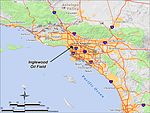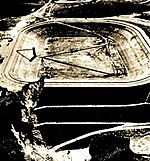Baldwin Hills (mountain range)
Baldwin Hills, Los AngelesBaldwin Hills (mountain range)Crenshaw, Los AngelesCulver City, CaliforniaGeography of Los Angeles ... and 8 more
Hills of CaliforniaMountain ranges of Los Angeles County, CaliforniaMountain ranges of Southern CaliforniaParks in Los Angeles County, CaliforniaSouth Los AngelesTourist attractions in Inglewood, CaliforniaTransverse RangesWestside (Los Angeles County)

The Baldwin Hills are a low mountain range surrounded by and rising above the Los Angeles Basin plain in central Los Angeles County, California. The Pacific Ocean is to the west, the Santa Monica Mountains to the north, Downtown Los Angeles to the northeast, and the Palos Verdes Hills to the south—with all easily viewed from the Baldwin Hills.
Excerpt from the Wikipedia article Baldwin Hills (mountain range) (License: CC BY-SA 3.0, Authors, Images).Baldwin Hills (mountain range)
South Fairfax Avenue,
Geographical coordinates (GPS) Address Nearby Places Show on map
Geographical coordinates (GPS)
| Latitude | Longitude |
|---|---|
| N 33.995277777778 ° | E -118.36388888889 ° |
Address
South Fairfax Avenue 5290
90056 , Ladera Heights
California, United States
Open on Google Maps











